| |
|
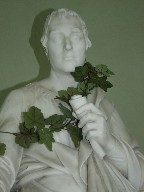 |
|
It had rained for weeks. The
fields of east Suffolk had dissolved
under the onslaught, the River Deben had
overflowed its lazy winding banks, and
even the country lanes were succumbing to
the waters of the flood. I was grateful
that my new bike had mudguards, otherwise
I would have been as wet as the road. As
it was, the rain was beginning to drizzle
again as I headed down from Saxmundham.
The sky was a leaden grey. Ordinarily I
wouldn't have been out exploring churches
on a day like this, but the weather had
been so utterly awful for the last week
that the slight let up today seemed an
opportunity to be seized. I
turned off the narrow lane onto the track
which led to Little Glemham church. As I
did so, a car coming from the track
braked heavily, and the driver wound down
his window. I could see at a glance that
they were not locals, probably Londoners,
and must have been staying at the holiday
cottage along the track. "Which way
to the A12?" he asked me
desperately. I looked into the back of
the car at the faces of three miserable
children, the luggage piled up behind
them. Beside the driver, his wife gazed
at me with a look of anguish. I pointed
them in the right direction, and with
heartfelt gratitude he sped off towards
the main road. I bet they won't be taking
a spring holiday in England again.
|
The track I was taking up
to the church was actually one of the side
entrances to the Glemham Hall estate. Glemham
Hall was once the home of the North family, but
in 1924 it was bought by newly-weds Sir Ivan and
Lady Blanche Cobbold, two of 20th Century
Suffolk's great eccentric characters. Blanche
Cobbold was born Blanche Cavendish, daughter of
the 9th Duke of Devonshire. Her brother's son
Andrew Cavendish, the 11th Duke, married Deborah
Mitford, one of the Mitford girls, still alive
today in her late nineties. Deborah's sister
Diana Mitford married Sir Oswald Mosley, leader
of the British Union of Fascists, and her sister
Unity Mitford was the lover of Adolf Hitler.
Hitler himself had met Blanche in the 1930s. She
was not impressed by him or by Mosley, or by
European fascism in general, but Hitler
pronounced her 'charming'. He was probably right.
Ivan and Blanche Cobbold married in 1919. Ivan
Cobbold was a member of the wealthy Ipswich
brewing family, their Cliff House estate
overlooking the brewery on Ipswich docks. When
Ivan and Blanche bought Glemham Hall, the family
sold off Cliff House. It was bought by the
Borough, and its grounds became Holywells Park. I
sit opposite its main entrance as I write this.
The Cobbold brewery, beside the park, had a
virtual monopoly of pubs in the Ipswich area.
Ivan Cobbold was a sporting man when it came to
the horses, but for business reasons he had to
forego a race meeting at Newmarket in the early
1930s to attend a football match at Arsenal. He
was hooked, and wondered why Ipswich did not have
a professional football team. He bankrolled the
unknown local amateurs Ipswich Town and persuaded
them to go professional with him as chairman. He
became known as the Man Who Made The Town. A few
short years later in 1936, Ipswich Town Football
Club entered the Football League for the first
time. Ambitious for success, the Cobbold family
appointed the young, untried Alfred Ramsey as
manager, and in April 1962, fifty years ago to
the day that I visited Little Glemham church,
Ipswich Town FC won the Football League
Championship, today known as the Premiership, the
only East Anglian team ever to win the highest
prize in English football.
Amongst the tree tops ahead of me a tower
appeared like a secret given up, hidden by a
cottage and the unresting castles of the elms.
This was St Andrew.
Uniquely
in east Suffolk in 2012, I had to go for a key,
and the key is a good mile or so off, in the
village close to the A12. But they were very nice
about it. The rain began to clear as I cycled
back to the church, and St Andrew is a singular
church, for one major reason and several little
ones. I hadn't been here for about ten years, and
so before I went inside I toured the building - I
always think of this as a kind of police check,
the scene of the crime before it is disrupted by
my visit. I remembered doing this here back at
the end of the 20th Century, and discovering a
guidebook error - the normally impeccable Mortlock reports
two crowned lion headstops flanking the west
doorway. But one is clearly a woodwose, its club
raised to bash out the brains of its companion.
Since the crowned lion is a symbol of the risen
Christ, one wonders at the theology behind such a
juxtaposition.
To the north of the church is a most
extraordinary extension. It is hard to think of
it as a transept - it is nearly as long as the
nave itself, and completely windowless. What on
earth could it be? Surely not the work of J.P. St
Aubyn, who restored this church in the 1850s? St
Aubyn was an architect of some character - you
can also find his work nearby at Great
Glemham and Sternfield, as well
as at Woolverstone and Huntingfield. No, this
is grim, oppressive, almost Teutonic, as if
Albert Speer had been working in the early years
of the 19th century. It looms out towards the
Hall, with Hall graves around it. If you don't
know what it is, and haven't guessed, then you
will shortly find out.
St Andrew can be rather a gloomy
church to step into, especially on a day like
this, but wth the flick of a few switches the
inside fills with light. The church is long and
narrow, tunnel-like even, but at the east end the
chancel is glorious, St Aubyn's vision of an Anglo-catholic heaven
perfectly realised. The only jarring note is the
massive classical column and archway entrance to
the northern extension. You take a few steps, and
all is revealed.
There, in grim isolation, sits Sir
Dudley North MP, who died in 1829. Its not him
really, of course, it's his statue. I once
described it on BBC Radio Suffolk as the ugliest
memorial to be found in any Suffolk church, which
resulted in some scorching e-mails from
parishioners, I can tell you. It should have a
classical gravitas about it, but the overwhelming
impression is of a languid bingo-caller,
microphone in hand. Two fat ladies, anyone? He
was born Dudley Long, and made his fortune by
inheriting Glemham Hall from his aunt, Ann
Herbert - the story is told on her memorial
nearby. The only condition was that he would
change his name, and being a Whig of some
character and integrity, he agreed, of course.
He sits in this vast anteroom with
other Glemham and North memorials lining the
walls, and space for the living Norths to sit at
his feet. Their access to this terrible place is
through the door we saw outside. They did not
need to meet the ordinary people of the parish on
their way to and from church, and they did not
even need to see them during divine service. Cautley described
the structure as 'a rather dreadful private pew',
unwilling to dignify it with the word
'Mausoleum'. North's statue was carved in Rome,
but Mortlock reports that the original was lost
at sea, and that some contemporaries did not
regard the replacement as a good likeness.
Perhaps it had been under-insured.
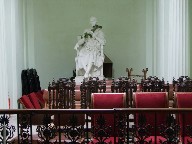 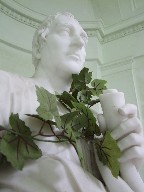
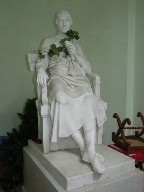
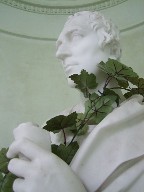
In one of those unlikely
juxtapositions which occur whenever a building is
refurbished continually over hundreds of years,
the window to the west of the Mausoleum is by the
great Margaret Edith Aldrich Rope. It shows the
Blessed Virgin and child with a halo of stars in
the middle flanked by two Gospel stories, the
summoning of the fishermen and the feeding of the
5000. Mortlock records that the window opposite
is by her elder cousin, Margaret Rope, a sequence
of the four ages of man, but it is actually by
Alfred Fisher for Powell & Sons. Whoever
whitewashed the wall above it was rather
careless.
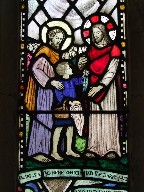 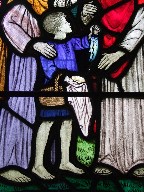 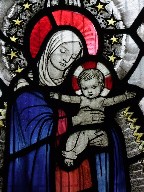 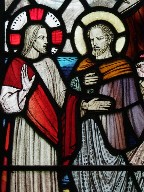  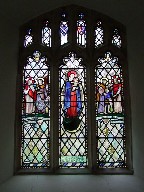
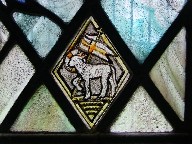 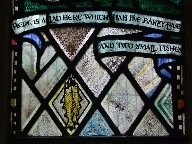 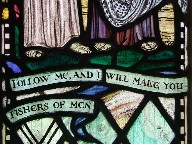 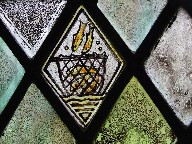
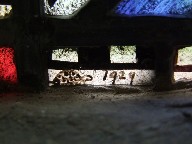 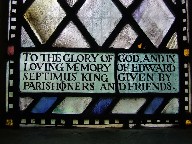 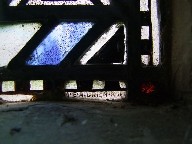
The carved tympanum depicting Laborare
est Orare ('to work is to pray') is the 1907
work of Ellen Rope, another member of that
talented family. I think that the pieta on the
war memorial is hers too. Above it hangs a fine
18th century decalogue, one of the best of its
kind in East Anglia, featuring Moses, Aaron and
Joshua above the tablets of the Law.
To the south of the sanctuary there is a
fascinating medieval survival. At the time of St
Aubyn's restoration, a relief representation of
the Holy Trinity was set into the wall. It is
unlikely to have come from this church originally
(St Aubyn had excellent contacts among the London
ecclesiastical suppliers) and it is badly
mutilated, but the figure of the crucified Christ
is clearly discernible. He hangs between the
Father's knees, the dove of the Holy Spirit
descending above his head. More complete examples
can be found at Framlingham and Blythburgh.
I stepped outside to find that the
sun had briefly made an appearance, so I wandered
around the churchyard retaking photographs of the
building. I pottered back to the outside of the
mausoleum again. The gravestone closest to the
door is for Lady Blanche Cobbold, who died in
1987. Her husband had been killed in the London
blitz, but In 1965 Lady Blanche Cobbold became
the president of Ipswich Town Football Club, a
position she would hold until her death. She was
the first and, in her lifetime, the only female
president of a professional football club. This
was at a time when the Cobbold family virtually
ran the club. Her sons John and Patrick Cobbold,
known to all as Mr John and Mr Patrick, would
accompany Alf Ramsey and his successor Bobby
Robson on trips to find players, and the Cobbold
family had a veto on signings. In the early
1980s, when ITFC fell into the relegation zone, a
national newspaper asked Patrick Cobbold if this
was a cause for panic. "Of course not",
he replied. "We only panic at Ipswich Town
when we run out of white wine in the
boardroom."
Lady Blanche followed Ipswich Town FC through
their finest years. In 1978, they won the FA Cup
at Wembley, beating Arsenal 1-0, the only East
Anglian team ever to win the trophy. A guest of
honour that day was the new leader of the
Conservative party, one Margaret Thatcher. The
Cobbolds were nothing if not Conservative, but
the parvenu qualities of the Iron Lady
would not have appealed to Lady Blanche any more
than those of the vulgar Adolf Hitler had.
Anxious to assert the correct and appropriate
protocols, an official of the Football
Association approached Lady Blanche, and invited
her to meet Mrs Thatcher. "Mrs
Thatcher?" said Lady Blanche. "You mean
- Margaret Thatcher?" The FA official
confirmed that they were one and the same.
"Good God", replied the grand Old Lady.
"Good God. I'd much rather have another Gin
and Tonic".
She was on the terraces when Ipswich won the UEFA
cup in 1982, the only East Anglian team ever to
win a European trophy. She died in 1987 with her
family still firmly in control of the club, and
the brewery still the owner of virtually all the
pubs in the Ipswich area.
But it was all coming to an
end. Margaret Thatcher had become Prime
Minister, and her loathing for the
aristocracy was almost as great as their
loathing for her. Her government ended
family breweries' monopoly holds on tied
houses. In the resultant scramble for
property, the Tolly Cobbold brewery was
bought out by Brent Walker in 1989, who
promptly closed the brewery down, selling
the pubs off at a vast profit to
multinational companies and property
developers. It was the beginning of the
end of the English pub.
The Conservative government then
orchestrated Rupert Murdoch's Sky TV deal
to create the Premiership, introducing
fabulous media wealth to English
football. In 1994, Patrick Cobbold died,
and Ipswich Town FC was bought out by a
consortium of businessmen, hungry for
some of that money. The club would never
win another major trophy, and Ipswich
Town now play in the second level of
English professional football. Today,
Glemham Hall is a venue for weddings and
car boot sales. |
 |
|
|
|
|

